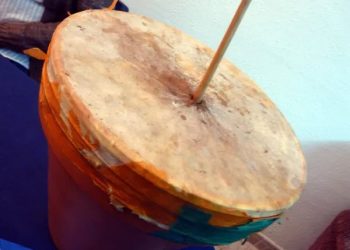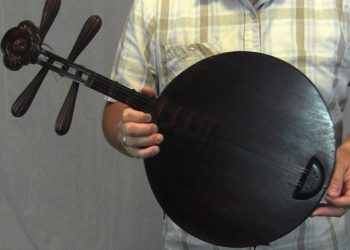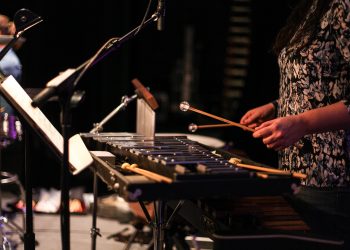Music is a universal language that has the power to connect people from all walks of life. It can evoke emotions, stir memories, and transport us to different times and places. For centuries, humans have created and played a wide variety of musical instruments, each with its unique sound and character. From drums and flutes to guitars and pianos, the world of musical instruments is vast and diverse.
In this article, we will take a closer look at 20 musical instruments that all have one thing in common: they start with the letter “M.” These instruments come from all around the world and span a range of genres and styles, from classical to rock and roll. Some are familiar favorites, while others may be new discoveries.
We will explore the history and cultural significance of each instrument, as well as their unique features and sounds. Whether you are a musician yourself or simply a music enthusiast, this article is sure to pique your curiosity and broaden your knowledge of the rich and varied world of musical instruments that begin with the letter “M”.
1. Maddalam
The maddalam is a special drum used in south Indian classical music. It is an hourglass-shaped percussion instrument that produces low, resonant sounds when struck with two sticks. This unique sound has made it a popular choice for accompaniment to traditional Carnatic vocal and instrumental performances.
The body of the maddalam consists of two drums connected by leather cords which are tuned differently. The right side, called the treble drum, produces higher pitched tones while the left side, known as the bass drum, provides lower notes. These two segments are played simultaneously to create complex rhythms and melodic patterns.
Playing techniques vary depending on regional styles but generally involve striking both sides of the drum alternatively with one stick held in each hand. In addition to producing rhythmically intricate pieces, players can also introduce improvisational elements into their playing by incorporating certain ornaments and movements such as rolls or trills.
Maddalams provide an essential foundation for any performance of Carnatic music and have been embraced by musicians all over India for centuries. With its distinct sound and wide range of applications, this beloved instrument continues to be a staple at concerts worldwide today.
2. Maguhu
The maguhu is another traditional percussion instrument popular in south Indian classical music. It is a cylindrical drum made of wood, metal or clay that produces deep and resonant tones when struck with two wooden sticks. This distinctive sound has become an essential part of Carnatic performances all over India for centuries.
Maguhus range in size from large to small and are typically tuned differently depending on the region they come from. Generally, larger drums produce lower notes while smaller ones provide higher pitches. Players use both hands to strike the heads alternatively, creating complex rhythms that can be adapted to various styles and tempos.
Playing techniques also vary greatly across different areas but generally involve using intricate finger movements combined with hand gestures such as rolls, trills and shakes. By incorporating these elements into their performance, musicians can add improvisational touches that make their playing unique. Additionally, some players will even blend vocalizations into their drumming technique to further enhance the effect of their music.
From its versatile sound to its wide variety of applications, it’s no wonder why the maguhu continues to remain so popular among performers today. Whether used as a solo instrument or accompaniment for other instruments, this beloved drum continues to captivate audiences everywhere with its mesmerizing rhythms and melodic patterns.
3. Mallets
Mallets are an essential tool for many percussion instruments, including the maguhu. Mallets come in a variety of shapes and sizes, each designed to produce different sounds on various surfaces. Generally speaking, mallets can be categorized into two main types: hard mallets and soft mallets. Hard mallets create a brighter sound with greater volume while softer ones generate more gentle tones at lower volumes.
While some players prefer to use just one type of mallet throughout their performance, others choose to alternate between the two depending on the music they’re playing. For example, hard mallets may be used when emphasizing certain rhythms or accents while soft mallets are better suited for producing subtler melodies that don’t overpower other instruments. Additionally, it is also possible to combine both types together for even more dynamic effects.
Regardless of which type you choose, proper technique is key for achieving optimal results from your instrument. This includes using precise motions and striking gently so as not to cause any damage to either the drum surface or heads themselves. With practice and patience, you too can master this skill and take your musical skills up a notch!
In addition to its musical applications, having a set of good-quality mallets also helps protect your instrument over time by preventing wear and tear due to regular use. Investing in quality products will ensure that your instrument remains in top condition no matter how often you play it – allowing you to continue enjoying its unique soundscape long into the future.
4. Mandobass
The mandobass is an often overlooked but highly versatile instrument. The large size and deep tone of this acoustic bass are perfect for providing the foundation in any ensemble, from jazz to classical. While many players prefer to use either a bow or fingers when playing this instrument, it can also be strummed with mallets depending on the desired sound effect.
In addition to its traditional role as part of a larger ensemble, the mandobass has also been used by soloist musicians to create unique arrangements that incorporate both melodic and rhythmic elements. This makes it an excellent tool for creating new musical ideas – offering up fresh possibilities for experienced performers alike.
Of course, learning how to play this instrument takes time and practice just like any other skill. There are several techniques you will need to master such as proper hand position and posture, finger dexterity, timing and coordination between hands, etc., all of which require patience and dedication to become proficient at them. Additionally, having access to quality instruction materials can help speed things up along your journey towards mastering the mandobass!
One thing is for sure: once you’ve spent enough time with the mandobass under your belt, you’ll be able to add depth and complexity to your performances like never before – pushing those limits far beyond what was formerly imaginable. So what are you waiting for? Get out there and start exploring this amazing instrument today!
5. Mandocello
The mandocello is an instrument that has been gaining in popularity over the past few years. It’s a larger version of the traditional mandolin and produces a deep, rich sound – perfect for producing both rhythm and melody when used as part of an ensemble or solo setting. Its size makes it easy to transport from gig to gig, making it a great choice for musicians on the go.
Learning how to play this unique instrument can be quite challenging but ultimately rewarding. The techniques required involve proper hand placement and coordination between both hands, learning complex finger patterns, developing muscle memory with fretting notes correctly, and more. As you progress along your journey to mastering the mandocello, expect intense practice sessions as well as plenty of self-discovery!
When playing this instrument live however, don’t forget to have fun too! Experimenting with various effects such as reverb and delay will really help breathe life into your performance while also helping you stand out from other players who are using standard tones. Additionally, exploring different genres like jazz or blues can open up new possibilities for creating interesting arrangements within each one – so why not give them all a try?
In short, there’s much potential when it comes to taking advantage of what the mandocello has to offer. With enough commitment and dedication towards honing your skills over time, you’ll find yourself becoming increasingly proficient at playing this impressive instrument – allowing you to produce amazing music full of depth and complexity!
6. Mandola
The mandola is a stringed instrument similar to the mandolin, but with a much deeper sound. It can be used as part of an ensemble or solo setting, and it’s ideal for producing both rhythm and melody. While playing this instrument may look intimidating at first glance due to its size, mastering the techniques involved isn’t impossible – in fact, it can be quite enjoyable!
Finger placement is crucial when playing the mandola; learning proper hand coordination between both hands and developing muscle memory when fretting notes correctly are important steps towards becoming proficient at this unique instrument. Additionally, exploring different musical genres helps bring more life into your performance while introducing new possibilities for arranging complex pieces. Experimenting with effects such as reverb and delay will also help give you that extra edge over other players who might be using standard tones.
It’s easy to see why many musicians today enjoy playing the mandola – from its deep resonance and wide range of styles available to explore, there’s no shortage of ways one can express themselves artistically on this remarkable instrument. Learning how to play takes patience and dedication, making sure you practice regularly while keeping sight of your goals along the way. With enough effort put in over time, soon you’ll find yourself creating beautiful melodies full of depth and complexity!
7. Mandolin
The mandolin is a versatile stringed instrument with eight strings, tuned in pairs, that produces bright and lively tones. It can be used to play both rhythm and melody parts, depending on the style of music being played. Mandolins come in many sizes and shapes, such as A-style or F-style models; each size has its own tonal characteristics due to the differences in body shape and scale length.
Playing this instrument requires good control of your fingers to get them into position quickly for every note you want to hit without buzzing. To become proficient at playing the mandolin, it’s important to practice regularly using scales and chords so that your technique becomes more natural over time. Additionally, exploring different genres like folk or jazz will help expand your musical palate while introducing new ideas for arranging complex pieces. Experimenting with effects such as tremolo and vibrato can also help add some flavor to your performances.
To master the mandolin takes dedication – from learning how to use proper picking techniques to developing muscle memory when fretting notes correctly – but it’s worth putting in the effort! With enough time spent practicing daily, soon you’ll be able to express yourself artistically through dynamic melodies full of life and color.
8. Mandora
Moving on from the mandolin, let’s explore the mandora. This plucked string instrument is similar to a lute and has been around since medieval times. It has four courses of two strings each; these are tuned in various ways depending on what type of music you’re playing. Mandoras have a much rounder body shape than most other lutes, which gives them a mellow yet powerful tone quality when played.
The technique used for this instrument involves strumming chords with one hand while fretting notes with the other – but it can be tricky! To get comfortable with it, start by practicing simple open chords and single-note lines like scales or melodies. Once you’ve got that down, try experimenting with different chord voicings and progressions to expand your repertoire even further. Additionally, adding techniques such as vibrato and slides will help bring out more emotion in your playing.
No matter how daunting learning the mandora may seem at first, remember that practice makes perfect! Just keep at it every day for an hour or so and you’ll gradually improve over time without noticing it until one day you realize just how far you’ve come from where you started. Plus, mastering this unique instrument offers some great rewards: not only does its sound add interesting texture to any musical style, but also many pieces composed for it feature beautiful harmonies that draw listeners into their captivating world.
9. Maracas
Continuing our exploration of musical instruments, let’s take a look at one that provides the perfect accompaniment for many types of music: maracas! These small handheld shakers are filled with seeds or beads and have been used in Latin American music since ancient times. They provide an upbeat rhythm to songs by producing a jingling sound when shaken.
Maracas require very little technique and can be played easily even by beginners. To start playing them, simply hold one in each hand and shake them back and forth in time with the beat of the song – you can also try varying your speed and intensity for different effects. Additionally, some players like to use their fingertips to produce more nuanced sounds as well as roll techniques for longer notes. With practice, you’ll soon find yourself creating complex rhythms on these fun instruments!
Although it may seem simple enough to just grab two maracas and start shaking away, there is actually quite a bit of skill involved in mastering this instrument. Many experienced players will incorporate various techniques such as alternating hands while playing different patterns simultaneously; they might also add accents here and there to emphasize certain beats within the context of the overall groove. This takes lots of practice but yields great results once you get it right.
No matter what type of music you’re into, having some maraca skills under your belt adds flavor to any performance! Not only do they spice up traditional genres like salsa or merengue, but they also work wonders when accompanying rock or hip-hop tunes too – truly making them one of the most versatile tools out there for musicians looking to inject life into their tracks.
10. Marimba
Switching gears from maracas, it’s now time to explore the rich sound of the marimba. This percussion instrument is made up of a series of wooden bars that are struck with mallets to create different tones and pitches. Often found in Latin American music styles like salsa, marimba players use their skillful techniques to bring out melodies from this unique instrument.
Unlike many other instruments which require years of training, getting started on the marimba can be relatively easy for beginners. All you need is a pair of good-quality mallets and some basic knowledge about how they should be used – typically by striking each bar at an angle towards the center. Once you have those basics down, you’ll be ready to start exploring all kinds of cool sounds!
Marimbas offer endless possibilities when it comes to crafting interesting rhythms and melodies. From simple single notes played one after another to complex polyrhythmic patterns, there’s no limit to what you can do with this versatile instrument. Additionally, because it has such a wide range of tones available (from low bass notes to high-pitched treble), it lends itself well to any genre – whether you’re playing jazz or funk, rock or classical music.
The marimba is truly an amazing musical tool that allows its players creative freedom while still providing structure and support within a song. With practice, anyone can master this incredible instrument and use it as part of their own personal expression through music!
11. Mbira
We now move onto the mbira, an ancient traditional African instrument. Also known as a thumb piano, this unique instrument is made up of metal keys attached to a wooden board that are plucked with one’s fingers in order to produce sound. The resonant vibration of each key creates a distinct reverberation that can be used to craft intricate melodies and rhythms.
The mbira has been around for centuries and is still widely played today – especially in Zimbabwe where it’s considered the national instrument. It’s often heard at ceremonies and celebrations since its warm tones evoke powerful emotions and memories within its listeners. But don’t let its traditional roots fool you; modern-day performers have also begun to incorporate the mbira into all sorts of genres from hip hop to indie rock!
Because of how simple it is to use, many people find playing the mbira quite rewarding even without any prior musical experience. All it takes is some basic knowledge about which finger should press which key along with lots of practice repeating patterns until they become second nature. With enough dedication, anyone can begin crafting beautiful sounds on this magical instrument.
The wonderful thing about the mbira is that there really aren’t any rules when it comes to playing – so feel free to experiment however you like! Whether you want to stick with classical styles or invent something entirely new, your creativity will be rewarded by the captivating music produced by these mesmerizing little keys. So why not give it a try?
12. Melodium
Our next instrument is the melodium, a modern-day mechanical piano that has been around since 1934. Its design is based on an earlier model of player pianos but with a more advanced system for creating sound. Instead of relying solely on traditional hammers and strings, the melodium includes multiple sets of metal reeds which are activated by pressing keys or playing rolls of paper. This allows it to produce complex harmonies with greater accuracy than ever before.
The sounds created by this remarkable machine can range from delicate and mellow tones to bright and energetic rhythms – perfect for any musical setting! And because it’s relatively easy to use, many people have turned to the melodium as their go-to source for making music in recent years. From classical compositions to jazz improvisations, its versatile capabilities make it ideal for all sorts of genres.
One downside to the melodium though is that it requires some upkeep in order to keep functioning properly; so if you’re looking into purchasing one, be sure you know how often you should clean and lubricate its parts. But regardless of these minor inconveniences, there’s no doubt about the fact that this instrument offers countless possibilities for self-expression and creativity! So why not explore what you can create?
No matter if you’re a beginner or a professional musician, the melodium provides an engaging way to get lost in your own world of sound and song. With enough practice and dedication, even those who’ve never touched a keyboard before might find themselves producing beautiful melodies in no time at all!
13. Mellotron
Building upon the concept of mechanical pianos, the mellotron is a modern electronic instrument that has been around since the 1960s. It uses an array of pre-recorded sounds and can be manipulated in various ways to produce different tones and effects. By utilizing tape loops, it allows musicians to layer up several voices or instruments at once – something that was previously only achievable by using multiple players on separate tracks.
The mellotron also features a distinctive look with its cabinetry made from wood, brushed steel and chrome. This makes it both visually interesting as well as sonically flexible; plus, its size means you can easily transport it for live performances or studio sessions. But despite all these conveniences, there’s still one downside: due to its age and design, some parts are prone to wear out over time – so if you do decide to get one make sure you keep up with regular maintenance!
Despite this minor issue though, the mellotron remains an incredibly popular choice among artists today who want to create lush soundscapes or unique accompaniments for their songs. Its ability to blend together multiple sources into a single track gives producers much more control over how they craft their music – allowing them to really bring each composition alive with creative flair! Plus, many contemporary acts have even begun incorporating vintage models into their recordings too – adding another dimension of nostalgia to their sound.
Whether used in production studios or concert halls across the world, the mellotron is truly a remarkable invention capable of producing vibrant sonic textures like no other instrument could. With enough practice and dedication, anyone can learn how to utilize its capabilities effectively – so why not explore what fascinating sounds await?
14. Mellophone
Continuing on from the unique sound of the mellotron, another instrument that has its own distinctive character is the mellophone. This brass instrument evolved out of a need for a higher-pitched version of the French horn and was first used by British military bands in the mid-19th century. Since then, it’s become popular in concert bands across different genres including jazz, classical and even marching music – thanks to its wide range of tones and dynamic capabilities.
The mellophone is usually pitched an octave above regular horns which gives it a brighter timbre than other instruments in this family. It also features three valves which can be adjusted to change notes quickly – making it easier to play fast passages or introduce intricate melodies into your performances. Plus, because of its shape, you’ll find most models have a greater projection power than their relatives too!
In addition to its tonal flexibility, many musicians appreciate how lightweight the mellophone is compared to other brass instruments – allowing them to move around freely during live shows without feeling weighed down. Its portability also makes it ideal for taking along with you when traveling; plus, its size means there are plenty of cases available so you can keep your instrument safe while on the go.
Overall, if you’re looking for an easy way to add some extra oomph and brightness to your ensemble then look no further than the mellophone. With enough practice, anyone can learn how to take advantage of all its benefits – whether playing solo parts or as part of a larger group performance!
15. Midi
In addition to traditional instruments, modern music production also relies heavily on MIDI technology. MIDI stands for Musical Instrument Digital Interface and it has revolutionized the way we create music by allowing us to connect different types of devices together and control them remotely.
MIDI is essentially a language that allows musical data to be sent back and forth between connected equipment – whether it’s synthesizers or computers. It works by assigning each note an individual signal which can then be transmitted over USB cables or wireless connections from one device to another. This makes it easy to sync up multiple elements, such as drums and basslines, in real-time without having to manually adjust them each time you want a change made.
The beauty of MIDI is that its compatible with nearly any type of instrument; so you’re not limited when it comes to experimenting with sounds and creating unique pieces of music. Plus, there are plenty of software programs available which make editing your tracks even easier – giving you access to powerful tools like sequencing, sampling and looping capabilities all within a single application!
Overall, if you’re looking for ways to take your productions beyond traditional methods then exploring MIDI could be just what you need. With enough practice, this powerful digital interface can open up countless possibilities in the studio – no matter what kind of genre you’re working in!
16. Moodswinger
The Moodswinger is a unique musical instrument that can be used to create interesting soundscapes. It’s perfect for those who want to explore the possibilities of music and get creative with their sounds. This instrument has been around since the 1970s, but its popularity has grown in recent years as more people have become aware of its potential.
This 12-string guitar-like device produces an array of weird and wonderful tones when strummed or plucked. Each string responds differently depending on how it’s played, making it possible to generate complex textures and rhythms from a single source. The strings are also able to produce vibrato effects if desired, which adds further depth and character to the sound produced by this remarkable instrument.
The Moodswinger is relatively easy to learn, even for beginners. Its simple design means there isn’t much technical knowledge required in order to play it effectively; all you need is your hands and some creativity! As such, this instrument offers great opportunities both for those looking to make music quickly without having any prior experience, as well as experienced musicians wanting to expand their sonic palette.
In short, the Moodswinger is versatile enough that anyone who wants to experiment with different kinds of sounds can do so easily – no matter what level they’re at musically. With its ability to create a wide range of sounds from one source and its ease of use, this multi-faceted musical tool deserves serious consideration for any musician’s arsenal.
17. Murchunga
Moving on from the Moodswinger, another interesting musical instrument is the Murchunga. This Australian wind instrument has been around since pre-colonial times and continues to be an integral part of modern Aboriginal music. It’s made up of a long wooden tube with small holes along its length which can be opened or closed in order to change the pitch produced when blowing through it. The player can also use their hands to manipulate the sound further, creating unique sounds that are not possible with other instruments.
The distinctive tone produced by this aerophone adds depth and character to traditional folksongs as well as contemporary compositions. Its portability makes it easy for groups of musicians to play together outdoors – something that would not be possible if they were using larger, heavier instruments like guitars or drums. Additionally, its simple design means anyone can learn how to play it quickly without needing any formal training.
What really sets the Murchunga apart though is its ability to produce shifting timbres depending on where you place your fingers over the holes while playing it. This gives each performance an unpredictable quality; no two pieces will ever sound exactly alike! Plus, even those who have never played one before can still create beautiful melodies with this remarkable instrument simply by experimenting and exploring what kind of sounds they can make.
For all these reasons, the Murchunga deserves attention for anyone looking for a unique way to express themselves musically. Whether you’re a complete beginner or experienced musician, this ancient tool offers endless possibilities and creative freedom for crafting your own personal soundscapes.
18. Musette De Cour
The Musette de Cour is another unique instrument with roots in the past that has made its way into modern music. This bagpipe-like instrument was a popular choice among French court musicians during the 17th and 18th centuries, but it can still be heard today in many different genres of music. Its distinct bellows and reed combination creates an airy yet full sound which stands out from other wind instruments.
Unlike traditional bagpipes, the Musette de Cour only has one drone pipe instead of two or three, making it easier to play for those who are just starting out. The small size also makes this aerophone portable enough to carry around without too much effort – perfect for playing impromptu jams outdoors! Additionally, unlike more complex brass instruments like trumpets or trombones, the Musette de Cour does not require any special skills or techniques; anyone can pick up this simple instrument and start producing beautiful melodies almost immediately.
For experienced players however, there’s plenty of room for exploration and personal expression as well. They can employ various ornamentation techniques such as grace notes or trills to add extra layers of complexity to their performances. Plus, they have access to a wide range of tunings which further opens up possibilities when creating new musical works.
In short, the Musette de Cour provides something for everyone regardless of skill level – a feature that few other instruments can match! Whether you’re looking for an easy introduction into playing wind instruments or want to explore some unique sounds while performing live concerts, this little gem will serve you well on your journey towards becoming a master musician.
19. Musical Pipes
Continuing our exploration of interesting and unusual instruments, let’s take a look at the Musical Pipes. These intriguing wind instruments are deceptively simple in their construction – consisting of just four or five bamboo pipes with small holes to create different notes. Despite this simplicity however, they can produce surprisingly rich sounds that often evoke a feeling of nostalgia when heard.
What makes musical pipes so special is their ability to imitate any kind of music depending on how it’s played. For example, if you play them softly then the sound will be gentle and delicate; but if you increase your speed and intensity then you’ll start hearing upbeat melodies instead! This versatility has made them popular among folk musicians who enjoy experimenting with unique sonic textures in their performances.
Another great thing about musical pipes is that they don’t require any prior knowledge or training before playing – anyone can pick one up and start creating music within minutes. Plus, since there are only 4-5 notes available at any given time, memorizing tunes becomes much easier compared to other wind instruments which have many more keys. Therefore, these lightweight instruments offer an ideal starting point for those interested in learning about traditional music without having to invest too much time or effort into mastering complex techniques first.
In short, musical pipes provide a wonderful opportunity for beginners as well as experienced players alike to explore various kinds of music while still enjoying the freedom to improvise freely whenever desired. Whether you want to relax with some soothing tunes after a long day or dance around wildly during your next jam session, these humble little tools won’t disappoint!
20. Mundharmonika
The next instrument we’ll be looking at is the Mundharmonika, also known as a harmonica or mouth organ. Although it may seem like a simple tool to use, this small and portable instrument can produce powerful sounds that are surprisingly complex in nature. Its strong yet delicate tones have made it an important part of many genres of music including folk, blues, country and even rock!
Unlike some other instruments which require extensive training before playing them properly, mastering the Mundharmonika requires very little practice. All you need to do is hold one end while blowing through its reeds to create beautiful melodies – no matter how much experience you have with musical instruments. This makes it ideal for those who want to learn more about traditional music but don’t feel confident enough to tackle larger wind instruments right away.
Another great thing about the Mundharmonika is its portability; since it’s so small and lightweight, anyone can take it with them wherever they go without having to lug around bulky equipment or cases. It even comes in several different sizes so that players of all levels can find something suitable for their needs! In addition, these pocket-sized tools offer endless opportunities for improvisation and creativity due to their unique design which allows users to play multiple notes simultaneously with just one breath.
Rather than relying on complicated techniques or expensive accessories, the Mundharmonika offers an accessible introduction into exploring various kinds of music – from gentle lullabies to upbeat jams – all within a single compact package! And thanks to its ultra-portable size and easy learning curve, this timeless instrument continues to captivate audiences everywhere with its soulful sonorities year after year.









